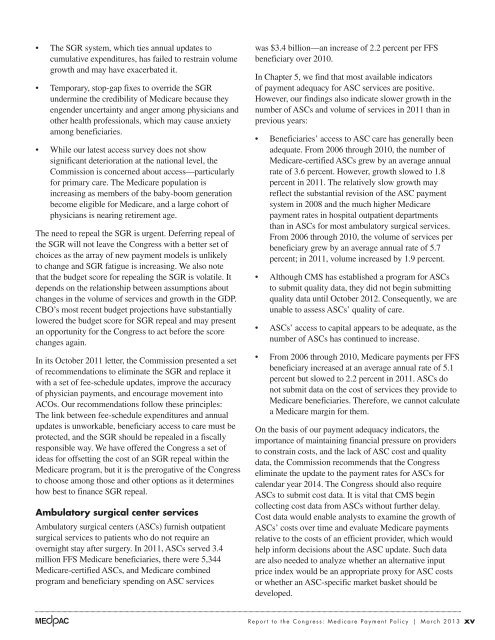Medicare Payment Policy
Medicare Payment Policy
Medicare Payment Policy
You also want an ePaper? Increase the reach of your titles
YUMPU automatically turns print PDFs into web optimized ePapers that Google loves.
• The SGR system, which ties annual updates to<br />
cumulative expenditures, has failed to restrain volume<br />
growth and may have exacerbated it.<br />
• Temporary, stop-gap fixes to override the SGR<br />
undermine the credibility of <strong>Medicare</strong> because they<br />
engender uncertainty and anger among physicians and<br />
other health professionals, which may cause anxiety<br />
among beneficiaries.<br />
• While our latest access survey does not show<br />
significant deterioration at the national level, the<br />
Commission is concerned about access—particularly<br />
for primary care. The <strong>Medicare</strong> population is<br />
increasing as members of the baby-boom generation<br />
become eligible for <strong>Medicare</strong>, and a large cohort of<br />
physicians is nearing retirement age.<br />
The need to repeal the SGR is urgent. Deferring repeal of<br />
the SGR will not leave the Congress with a better set of<br />
choices as the array of new payment models is unlikely<br />
to change and SGR fatigue is increasing. We also note<br />
that the budget score for repealing the SGR is volatile. It<br />
depends on the relationship between assumptions about<br />
changes in the volume of services and growth in the GDP.<br />
CBO’s most recent budget projections have substantially<br />
lowered the budget score for SGR repeal and may present<br />
an opportunity for the Congress to act before the score<br />
changes again.<br />
In its October 2011 letter, the Commission presented a set<br />
of recommendations to eliminate the SGR and replace it<br />
with a set of fee-schedule updates, improve the accuracy<br />
of physician payments, and encourage movement into<br />
ACOs. Our recommendations follow these principles:<br />
The link between fee-schedule expenditures and annual<br />
updates is unworkable, beneficiary access to care must be<br />
protected, and the SGR should be repealed in a fiscally<br />
responsible way. We have offered the Congress a set of<br />
ideas for offsetting the cost of an SGR repeal within the<br />
<strong>Medicare</strong> program, but it is the prerogative of the Congress<br />
to choose among those and other options as it determines<br />
how best to finance SGR repeal.<br />
Ambulatory surgical center services<br />
Ambulatory surgical centers (ASCs) furnish outpatient<br />
surgical services to patients who do not require an<br />
overnight stay after surgery. In 2011, ASCs served 3.4<br />
million FFS <strong>Medicare</strong> beneficiaries, there were 5,344<br />
<strong>Medicare</strong>-certified ASCs, and <strong>Medicare</strong> combined<br />
program and beneficiary spending on ASC services<br />
was $3.4 billion—an increase of 2.2 percent per FFS<br />
beneficiary over 2010.<br />
In Chapter 5, we find that most available indicators<br />
of payment adequacy for ASC services are positive.<br />
However, our findings also indicate slower growth in the<br />
number of ASCs and volume of services in 2011 than in<br />
previous years:<br />
• Beneficiaries’ access to ASC care has generally been<br />
adequate. From 2006 through 2010, the number of<br />
<strong>Medicare</strong>-certified ASCs grew by an average annual<br />
rate of 3.6 percent. However, growth slowed to 1.8<br />
percent in 2011. The relatively slow growth may<br />
reflect the substantial revision of the ASC payment<br />
system in 2008 and the much higher <strong>Medicare</strong><br />
payment rates in hospital outpatient departments<br />
than in ASCs for most ambulatory surgical services.<br />
From 2006 through 2010, the volume of services per<br />
beneficiary grew by an average annual rate of 5.7<br />
percent; in 2011, volume increased by 1.9 percent.<br />
• Although CMS has established a program for ASCs<br />
to submit quality data, they did not begin submitting<br />
quality data until October 2012. Consequently, we are<br />
unable to assess ASCs’ quality of care.<br />
• ASCs’ access to capital appears to be adequate, as the<br />
number of ASCs has continued to increase.<br />
• From 2006 through 2010, <strong>Medicare</strong> payments per FFS<br />
beneficiary increased at an average annual rate of 5.1<br />
percent but slowed to 2.2 percent in 2011. ASCs do<br />
not submit data on the cost of services they provide to<br />
<strong>Medicare</strong> beneficiaries. Therefore, we cannot calculate<br />
a <strong>Medicare</strong> margin for them.<br />
On the basis of our payment adequacy indicators, the<br />
importance of maintaining financial pressure on providers<br />
to constrain costs, and the lack of ASC cost and quality<br />
data, the Commission recommends that the Congress<br />
eliminate the update to the payment rates for ASCs for<br />
calendar year 2014. The Congress should also require<br />
ASCs to submit cost data. It is vital that CMS begin<br />
collecting cost data from ASCs without further delay.<br />
Cost data would enable analysts to examine the growth of<br />
ASCs’ costs over time and evaluate <strong>Medicare</strong> payments<br />
relative to the costs of an efficient provider, which would<br />
help inform decisions about the ASC update. Such data<br />
are also needed to analyze whether an alternative input<br />
price index would be an appropriate proxy for ASC costs<br />
or whether an ASC-specific market basket should be<br />
developed.<br />
Report to the Congress: <strong>Medicare</strong> <strong>Payment</strong> <strong>Policy</strong> | March 2013<br />
xv


